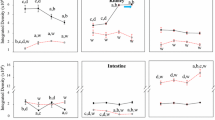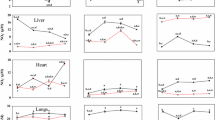Abstract
Suprachiasmatic nucleus (SCN) contains the central clock that orchestrate circadian rhythms in physiology and behavior in mammals. Tightly interlocked transcriptional and translational feedback loops (TTFLs) comprising of various clock genes such as Clock, Bmal1, Periods, Cryptochromes etc. in the SCN, send the timing signals to peripheral clocks that governs local metabolism with similar TTFLs. Peripheral clocks in kidney regulates several circadian rhythms like blood pressure, immunity etc. However, aging leads to circadian and inflammatory disorders in kidney. Though there are increasing evidences on age associated perturbations, studies elucidating the rhythmic expression of clock and immune genes across aging in kidney are obscure. We therefore studied changes in daily rhythms of clock and immune genes in kidney. In this study we measured mRNA expression of clock genes rBmal1, rPer1, rPer2, rCry1, rCry2, rRev-erbα, rRorα, and inflammatory genes rNfκb1, rTnfα, rIl6, rTlr4 and rTlr9 in 3, 12 and 24 months male Wistar rat kidney using qRT-PCR. From our study, we did not observe significant changes in clock genes expression except rRorα, but immune genes showed significant phase alterations as well as increase in mean 24 h levels. Pearson correlation analysis of data showed desynchronization between immune and clock genes expression. We further studied the effect of administration of curcumin which has anti-aging, anti-inflammatory, anti-oxidant etc. properties, and evaluated its chronobiotic properties. We here report differential effects of curcumin administration on daily rhythms of clock and immune genes expression.






Similar content being viewed by others
References
Arjona A, Sarkar DK (2005) Circadian oscillations of clock genes, cytolytic factors, and cytokines in rat NK cells. J Immunol 174:7618–7624
Astafev AA, Patel SA, Kondratov RV (2017) Calorie restriction effects on circadian rhythms in gene expression are sex dependent. Sci Rep 7:9716
Balsalobre A (2002) Clock genes in mammalian peripheral tissues. Cell Tissue Res 309:193–199
Bolignano D, Mattace-Raso F, Sijbrands EJ, Zoccali C (2014) The aging kidney revisited: a systematic review. Ageing Res Rev 14:65–80
Cermakian N, Lange T, Golombek D, Sarkar D, Nakao A, Shibata S, Mazzoccoli G (2013) Crosstalk between the circadian clock circuitry and the immune system. Chronobiol Int 30:870–888
Chen J, Kieswich JE, Chiazza F, Moyes AJ, Gobbetti T, Purvis GS, Salvatori DC, Patel NS, Perretti M, Hobbs AJ, Collino M (2016) IκB kinase inhibitor attenuates sepsis-induced cardiac dysfunction in CKD. J Am Soc Nephrol 28:94–105
Chomczynski P, Sacchi N (2006) Single-step method of RNA isolation by acid guanidinium thiocyanate-phenol-chloroform extraction: twenty-something years on. Nat Protoc 1:581–585
Christiansen SL, Bouzinova EV, Fahrenkrug J, Wiborg O (2016) Altered expression pattern of clock genes in a rat model of depression. Int J Neuropsychopharmacol. https://doi.org/10.1093/ijnp/pyw061
Curtis AM, Bellet MM, Sassone-Corsi P, O’Neill LA (2014) Circadian clock proteins and immunity. Immunity 40:178–186
Dibner C, Schibler U, Albrecht U (2010) The mammalian circadian timing system:organization and coordination of central and peripheral clocks. Annu Rev Physiol 72:517–549
Doi M, Takahashi Y, Komatsu R, Yamazaki F, Yamada H, Haraguchi S, Emoto N, Okuno Y, Tsujimoto G, Kanematsu A, Ogawa O (2010) Salt-sensitive hypertension in circadian clock-deficient Cry-null mice involves dysregulated adrenal Hsd3b6. Nat Med 16:67–74
Douma LG, Cheng KY, Lynch IJ, Holzworth M, Masten S, Barral D, Miller A, Esser KA, Wingo CS, Gumz ML (2018) Kidney-specific KO of the circadian clock protein BMAL1 lowers blood pressure in male C57BL/6 J mice. FASEB J 32(1_supplement):905–906
Fontaine C, Rigamonti E, Pourcet B, Duez H, Duhem C, Fruchart JC, Chinetti-Gbaguidi G, Staels B (2008) The nuclear receptor Rev-erbα is a liver X receptor (LXR) target gene driving a negative feedback loop on select LXR-induced pathways in human macrophages. Mol Endocrinol 22:1797–1811
Gumz ML, Stow LR, Lynch IJ, Greenlee MM, Rudin A, Cain BD, Weaver DR, Wingo CS (2009) The circadian clock protein Period 1 regulates expression of the renal epithelial sodium channel in mice. J Clin Invest 119:2423–2434
Haloui M, Tremblay J, Seda O, Koltsova SV, Maksimov GV, Orlov SN, Hamet P (2013) Increased renal epithelial Na channel expression and activity correlate with elevation of blood pressure in spontaneously hypertensive rats. Hypertension 62:731–737
Hara M, Minami Y, Ohashi M, Tsuchiya Y, Kusaba T, Tamagaki K, Koike N, Umemura Y, Inokawa H, Yagita K (2017) Robust circadian clock oscillation and osmotic rhythms in inner medulla reflecting cortico-medullary osmotic gradient rhythm in rodent kidney. Sci Rep 7:7306
Hart EC, Charkoudian N (2014) Sympathetic neural regulation of blood pressure:influences of sex and aging. Physiology (Bethesda) 29:8–15
Hatori M, Gronfier C, Van Gelder RN, Bernstein PS, Carreras J, Panda S, Marks F, Sliney D, Hunt CE, Hirota T, Furukawa T (2017) Global rise of potential health hazards caused by blue light-induced circadian disruption in modern aging societies. NPJ Aging Mech Dis 3:9
Hewlings SJ, Kalman DS (2017) Curcumin: a review of its’ effects on human health. Foods 6:92
Hoesel B, Schmid JA (2013) The complexity of NF-κB signaling in inflammation and cancer. Mol Cancer 12:86
Jagota A (2012) Age-induced alterations in biological clock:therapeutic effects of melatonin. In: Thakur MK, Rattan SIS (eds) Brain aging and therapeutic interventions. Springer, London, pp 111–129
Keller M, Mazuch J, Abraham U, Eom GD, Herzog ED, Volk HD, Kramer A, Maier B (2009) A circadian clock in macrophages controls inflammatory immune responses. Proc Natl Acad Sci USA 106:21407–21412
Kukkemane K, Jagota A (2019) Therapeutic effects of curcumin on age-induced alterations in daily rhythms of clock genes and Sirt1 expression in the SCN of male Wistar rats. Biogerentology. https://doi.org/10.1007/s10522-018-0979-y
Mattam U, Jagota A (2014) Differential role of melatonin in restoration of age-induced alterations in daily rhythms of expression of various clock genes in suprachiasmatic nucleus of male Wistar rats. Biogerontology 15:257–268
Narasimamurthy R, Hatori M, Nayak SK, Liu F, Panda S, Verma IM (2012) Circadian clock protein cryptochrome regulates the expression of proinflammatory cytokines. Proc Natl Acad Sci USA 109:12662–12667
Paladino N, Mul Fedele ML, Duhart JM, Marpegan L, Golombek DA (2014) Modulation of mammalian circadian rhythms by tumor necrosis factor-α. Chronobiol Int 31:668–679
Pizarro A, Hayer K, Lahens NF, Hogenesch JB (2013) CircaDB: a database of mammalian circadian gene expression profiles. Nucleic Acids Res 41:1009–1013
Roenneberg T, Merrow M (2016) The circadian clock and human health. Curr Biol 26:432–443
Saifur Rohman M, Emoto N, Nonaka H, Okura R, Nishimura M, Yagita K, van der Horst GT, Matsuo M, Okamura H, Yokoyama M (2005) Circadian clock genes directly regulate expression of the Na(+)/H(+) exchanger NHE3 in the kidney. Kidney Int 67:1410–1419
Scheiermann C, Kunisaki Y, Frenette PS (2013) Circadian control of the immune system. Nat Rev Immunol 13:190–198
Schibler U, Gotic I, Saini C, Gos P, Curie T, Emmenegger Y, Sinturel F, Gosselin P, Gerber A, Fleury-Olela F, Rando G (2015) Clock-talk: interactions between central and peripheral circadian oscillators in mammals. Cold Spring Harb Symp Quant Biol 80:223–232
Silver AC, Arjona A, Walker WE, Fikrig E (2012) The circadian clock controls toll-like receptor 9-mediated innate and adaptive immunity. Immunity 36:251–261
Silver AC, Buckley SM, Hughes ME, Hastings AK, Nitabach MN, Fikrig E (2018) Daily oscillations in expression and responsiveness of Toll-like receptors in splenic immune cells. Heliyon 4:e00579
Solt LA, Kojetin DJ, Burris TP (2011) The REV-ERBs and RORs: molecular links between circadian rhythms and lipid homeostasis. Future Med Chem 3:623–638
Spengler ML, Kuropatwinski KK, Comas M, Gasparian AV, Fedtsova N, Gleiberman AS, Gitlin II, Artemicheva NM, Deluca KA, Gudkov AV, Antoch MP (2012) Core circadian protein CLOCK is a positive regulator of NF-κB-mediated transcription. Proc Natl Acad Sci USA 109:2457–2465
Stow LR, Gumz ML (2011) The circadian clock in the kidney. J Am Soc Nephrol 22:598–604
Sugimoto T, Morioka N, Zhang FF, Sato K, Abe H, Hisaoka-Nakashima K, Nakata Y (2014) Clock gene Per1 regulates the production of CCL2 and interleukin-6 through p38, JNK1 and NF-κB activation in spinal astrocytes. Mol Cell Neurosci 59:37–46
Takahashi JS (2017) Transcriptional architecture of the mammalian circadian clock. Nat Rev Genet 18:164–179
Takeda Y, Jothi R, Birault V, Jetten AM (2012) RORγ directly regulates the circadian expression of clock genes and downstream targets in vivo. Nucleic Acids Res 40:8519–8535
Tilstra JS, Clauson CL, Niedernhofer LJ, Robbins PD (2011) NF-κB in aging and disease. Aging Dis 2:449–465
Tognini P, Murakami M, Sassone-Corsi P (2018) Interplay between microbes and the circadian clock. Cold Spring Harb Perspect Biol 10:a028365
Vinod C, Jagota A (2017) Daily Socs1 rhythms alter with aging differentially in peripheral clocks in male Wistar rats: therapeutic effects of melatonin. Biogerontology 18:333–345
Wang H, Li J, Gai Z, Kullak-Ublick GA, Liu Z (2017) TNF-α deficiency prevents renal inflammation and oxidative stress in obese mice. Kidney Blood Press Res 42:416–427
Wardyn JD, Ponsford AH, Sanderson CM (2015) Dissecting molecular cross-talk between Nrf2 and NF-κB response pathways. Biochem Soc Trans 43:621–626
Xi Y, Shao F, Bai XY, Cai G, Lv Y, Chen X (2014) Changes in the expression of the Toll-like receptor system in the aging rat kidneys. PLoS ONE 9:e96351
Yang L, Chu Y, Wang LA, Wang Y, Zhao X, He W, Zhang P, Yang X, Liu X, Tian L, Li B (2015) Overexpression of CRY1 protects against the development of atherosclerosis via the TLR/NF-κB pathway. Int Immunopharmacol 28:525–530
Yang G, Chen L, Grant GR, Paschos G, Song WL, Musiek ES, Lee V, McLoughlin SC, Grosser T, Cotsarelis G, FitzGerald GA (2016) Timing of expression of the core clock gene Bmal1 influences its effects on aging and survival. Sci Transl Med 8(324):324ra16
Zhu HT, Bian C, Yuan JC, Chu WH, Xiang X, Chen F, Wang CS, Feng H, Lin JK (2014) Curcumin attenuates acute inflammatory injury by inhibiting the TLR4/MyD88/NF-κB signaling pathway in experimental traumatic brain injury. J Neuroinflamm 11:59
Acknowledgement
The work is supported by ICMR grant (Ref. No. 55/7/2012-/BMS) to AJ. AJ is also thankful to DST Purse Grant to University of Hyderabad. NBT is thankful to UGC for SRF.
Author information
Authors and Affiliations
Corresponding author
Additional information
Publisher's Note
Springer Nature remains neutral with regard to jurisdictional claims in published maps and institutional affiliations.
Electronic supplementary material
Below is the link to the electronic supplementary material.
10522_2019_9813_MOESM1_ESM.pptx
Supplementary material 1—Melt curves of all the genes studied. Single peak represents specific amplification (PPTX 958 kb)
Rights and permissions
About this article
Cite this article
Thummadi, N.B., Jagota, A. Aging renders desynchronization between clock and immune genes in male Wistar rat kidney: chronobiotic role of curcumin. Biogerontology 20, 515–532 (2019). https://doi.org/10.1007/s10522-019-09813-6
Received:
Accepted:
Published:
Issue Date:
DOI: https://doi.org/10.1007/s10522-019-09813-6




